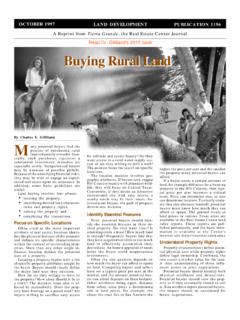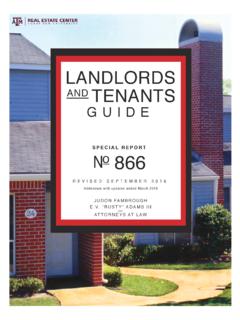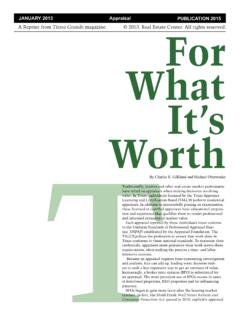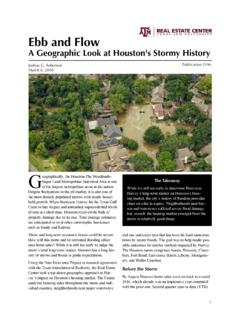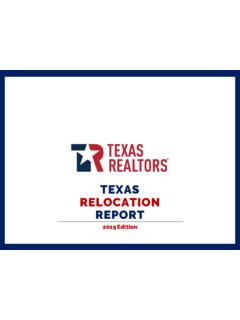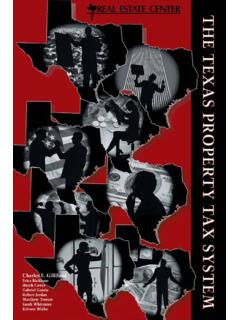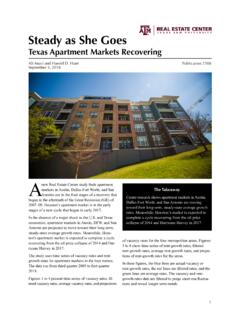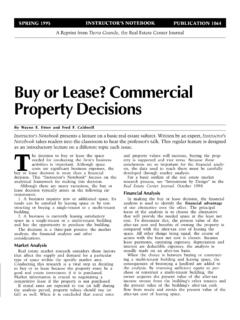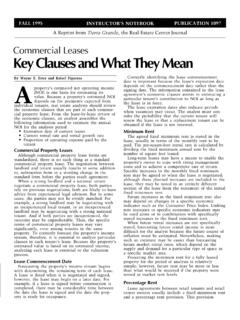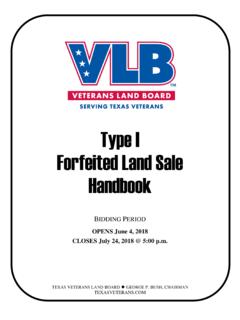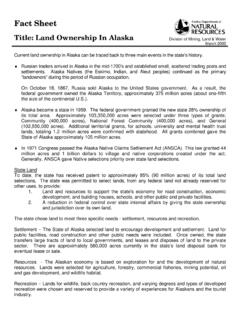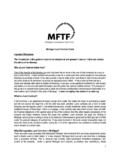Transcription of Landlocked Property - Texas A&M University
1 SOLUTIONS THROUGH RESEARCHS eptember 1992 Vol. 7, No. 1947 Landlocked Property A Reprint FromEasementsWhen buying Property , the three most important items are location, location and location. A corollary to this rule is that once the prime location is found, the Property must have access, access and access. It is possible to buy Landlocked Property in Texas , Property having no routes of ingress and land and land titles become more and more fractured, the issue of access has come to the forefront. In 1991, Procedural Rule P-37 was adopted by the Texas State Board of Insurance. All title policies issued after October 1, 1991, insure the right of access unless a specific exception is added. Neither the width of the access nor access to a public thoroughfare is insured, Property does not touch (or is not contiguous to) a public road-way, access can be gained only by crossing another's land .
2 Permission, if granted, will be in the form of a private right-of-way agreement, better known as an easement is the right of a person to use the land of another for a specific purpose. Easements may be classified in several ways, but the two most common are easements in gross and appurtenant easement in gross is granted to and vests in a person. It is the personal right to cross another's land . It cannot be presumed and is not favored by law. Generally, ease-ments in gross are not appurtenant easement, on the other hand, attaches to a tract of land , not to a person. The right to use the easement passes with the title to the appurtenant easement re-quires two estates or tenements, a dominant and a servient. The dominant tenement is the ben-efited estate.
3 The owner of the dominant estate has the right to cross the servient or burdened land . The servient estate is the one upon which the easement rests. Purchasers of land served by an express easement should verify that the easement is appurtenant and not one in gross to the for-mer owner. Also, the purchaser should check with the owner of the servient estate to make sure the easement has not terminated or is in Case LawIf a prospective tract has no express easement, Texas case law recognizes several types of easements that may avail the purchaser. These include ease-ments created by prescription, estoppel, implication or necessity. A synopsis of each follows. Prescription easements are ease-ments that arise from the con-tinuous use of another's Property without consent.
4 Prescription easements are created in much the same manner as title to land is acquired by adverse possession. The requirements are major differences are that adverse possession requires con-tinuous possession of the Property while a prescriptive easement requires continuous use. Also, adverse possession matures into title, while the latter evolves into an basic requirements must be met to create a prescriptive ease-ment. The absence of any is use of the easement must begin and continue without the consent of the landowner, be open, obvious and apparent, be exclusive, be in the same place or within definite lines and be continuous and uninterrupt-ed for ten who buy land hav-ing only a prescriptive easement for access should make sure the circumstances giving rise to the easement are carefully documented and filed in the deed records.
5 The purchaser may ask the seller to warrant the existence of the ease-ment and indemnify the buyer in the event of its by estoppel are cre-ated by the acts or expressions of a landowner indicating the existence or creation of a partic-ular easement. If another person relies on the representations and purchases or improves Property based on them, the landowner is estopped (or legally prevented) from denying the easement's should never buy land based on an easement by estoppel. If a lawsuit is needed to prove such an easement, it could be expensive, time consuming and unsuccessful. Before purchas-ing, the buyer should demand an express appurtenant easement from the landowner and not rely on oral third type of unexpressed easement is an implied easement.
6 Depending on the circumstances, implied easements may be either granted or reserved. The basic premise for either is that the seller intended to grant or reserve the easement but, for some reason, overlooked it at prerequisite for implied ease-ments is that the dominant and servient tenements were united under the seller prior to the last conveyance. The owner sells one of the tracts and retains the the owner sells the tract needing the easement but fails to convey an easement across the retained tract, it is called an im-plied the other hand, if the own-er retains the tract needing the easement but fails to reserve an easement across the tract that was sold, it is called an implied is some authority that the courts will recognize an implied grant more readily than an implied reservation.
7 The law implies an easement in favor of the grantee more readily than in favor of the create either type of implied easement, four conditions are required. The dominant and servient estates must have been under common ownership. The roadway serving as the needed easement was in exis-tence and being used prior to the division of the estates. The use of the roadway was apparent, permanent, contin-uous and necessary for the enjoyment of the dominant estate before the estates were severed. The easement to the dominant tract is reasonably necessary after the should not buy prop-erty relying on an implied grant or reservation of an easement. The rationale behind either type is that the parties intended to grant or reserve the easement but overlooked it at closing.
8 Purchasers should not overlook the inclusion of any easements at by necessity are the last type of easement that may arise without formal expression. They represent the last hope many landowners have to avoid land -locked Property . In some respects, easements by necessity are similar to implied easements. First, prior ownership of the dominant and ser-vient estates is required. However, the unit of ownership may occur anytime in the chain of title and not necessarily prior to the last , the rationale for both types of easements is the same. The courts presume the parties intended the easement but over-looked it for some reason. Because of this rationale and because prior unity of title is required, an ease-ment by necessity may be claimed by either the grantee or grantor de-pending upon which party needs , both types of easements require some degree of necessi-ty.
9 In other words, both require some inconvenience in accessing the Property . Generally, implied easements insure the same con-venience and comfort for the enjoyment of the dominant estate that existed prior to the severance of the two tracts. However, an easement by necessity requires the tract to be absolutely an implied easement by ne-cessity to arise, three conditions must be met. There was, at one time, uni-ty of ownership (or common ownership) of the dominant and servient estates. The common ownership, howev-er, must have occurred after the land was patented, , conveyed from the sovereign to private ownership. The easement must be abso-lutely necessary for the owner to enter and leave the Property . No other routes of ingress and egress exist.
10 The necessity for the easement existed when the dominant and servient estates were privity of ownership, the mere fact that a person's land is completely surrounded by oth-ers is not sufficient to create an easement by who buy land relying on the presence of an easement by necessity should research the chain of title carefully to insure a right of access. Supporting af-fidavits should be filed of record to insure preservation of evidence. An indemnity agreement from the seller assuring the purchaser of the easement is necessity of an easement to access Property cannot be over-emphasized. Its importance ranks with the location of Property . In-dependent research and assurances should be conducted and acquired prior to purchasing questionable Property .
